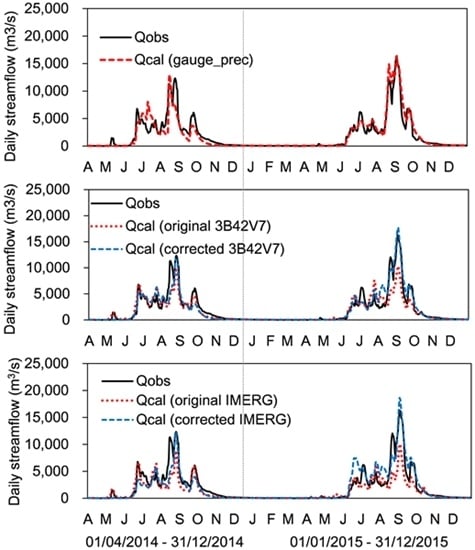Assessment of GPM and TRMM Multi-Satellite Precipitation Products in Streamflow Simulations in a Data-Sparse Mountainous Watershed in Myanmar
Abstract
:1. Introduction
2. Study Area and Data Preparation
2.1. Study Area
2.2. Gauge-Based Weather Data
2.3. Satellite Precipitation Products
2.4. Streamflow Data
3. Methodology
3.1. Evaluation Indicators for Satellite Precipitation Products
3.2. Bias-Correction for Satellite Precipitation Products
3.3. Xinanjiang Hydrological Model
3.4. Streamflow Simulation Schemes
4. Results
4.1. Evaluation of Satellite Precipitation Products
4.1.1. Spatial Patterns
4.1.2. Daily Precipitation
4.1.3. Monthly Precipitation
4.2. Evaluation of Streamflow Simulations
4.2.1. Daily Streamflow
4.2.2. Monthly Streamflow
5. Discussion
6. Conclusions
- (1)
- In general, IMERG and 3B42V7 represent a similar spatial pattern over the Chindwin River basin, demonstrating a decreasing trend from north to south. IMERG provides a more detailed spatial information of precipitation than 3B42V7, due to its native resolution of 0.1° × 0.1° compared to 3B42V7’s 0.25° × 0.25°.
- (2)
- Although IMERG and 3B42V7 can capture the temporal variation patterns of daily precipitation at the five rain gauges, these two products still contain considerable errors. IMERG significantly underestimates the total precipitation at all the gauges, and 3B42V7 presents a moderate underestimation at three out of the five gauges. Both products performed poorly in heavy- and light-rain detections and estimations, with a considerable underestimation of heavy-rain estimates and a significant positive bias of light-rain estimates. The accuracy of IMERG and 3B42V7 in estimating monthly precipitation is significantly improved, compared to daily precipitation estimates. Overall, 3B42V7 outperforms IMERG at four out of the five gauges.
- (3)
- The large errors in IMERG and 3B42V7 distinctly spread in streamflow simulations via the XAJ hydrological model, with the significant systematic underestimation of total runoff and high flow. The IMERG-based simulations perform worse than those of 3B42V7. The bias correction of satellite precipitation estimates effectively improves the performance of daily and monthly streamflow simulations using IMERG and 3B42V7 data sets. The corrected 3B42V7-based simulations perform slightly better than those using the gauge-based precipitation. In general, IMERG and 3B42V7 are both feasible in streamflow simulations in the Chindwin River basin, with the 3B42V7 product being better suited than IMERG.
Supplementary Materials
Acknowledgments
Author Contributions
Conflicts of Interest
References
- Hou, A.Y.; Kakar, R.K.; Neeck, S.; Azarbarzin, A.A.; Kummerow, C.D.; Kojima, M.; Oki, R.; Nakamura, K.; Iguchi, T. The global precipitation measurement mission. Bull. Am. Meteorol. Soc. 2014, 95, 701–722. [Google Scholar] [CrossRef]
- Hsu, K.; Gao, X.; Sorooshian, S.; Gupta, H.V. Precipitation estimation from remotely sensed information using artificial neural networks. J. Appl. Meteorol. 1997, 36, 1176–1190. [Google Scholar] [CrossRef]
- Joyce, R.J.; Janowiak, J.E.; Arkin, P.A.; Xie, P. CMORPH: A method that produces global precipitation estimates from passive microwave and infrared data at high spatial and temporal resolution. J. Hydrometeorol. 2004, 5, 487–503. [Google Scholar] [CrossRef]
- Aonashi, K.; Awaka, J.; Hirose, M.; Kozu, T.; Kubota, T.; Liu, G.; Shige, S.; Kida, S.; Seto, S.; Takahashi, N.; et al. GSMaP passive, microwave precipitation retrieval algorithm: Algorithm description and validation. J. Meteorol. Soc. Jpn. 2009, 87A, 119–136. [Google Scholar] [CrossRef]
- Huffman, G.J.; Bolvin, D.T.; Nelkin, E.J.; Wolff, D.B.; Adler, R.F.; Gu, G.; Hong, Y.; Bowman, K.P.; Stocker, E.F. The TRMM multisatellite precipitation analysis (TMPA): Quasi-global, multiyear, combined-sensor precipitation estimates at fine scales. J. Hydrometeorol. 2007, 8, 38–55. [Google Scholar] [CrossRef]
- Nikolopoulos, E.I.; Anagnostou, E.N.; Borga, M. Using High-resolution Satellite Rainfall Products to Simulate a Major Flash Flood Event in Northern Italy. J. Hydrometeorol. 2013, 14, 171–185. [Google Scholar] [CrossRef]
- Tuo, Y.; Duan, Z.; Disse, M. Evaluation of precipitation input for SWAT modeling in Alpine catchment: A case study in the Adige river basin (Italy). Sci. Total Environ. 2016, 573, 66–82. [Google Scholar] [CrossRef] [PubMed]
- Ciabatta, L.; Brocca, L.; Massari, C. Rainfall-runoff modelling by using SM2RAIN-derived and state-of-the-art satellite rainfall products over Italy. Int. J. Appl. Earth Obs. 2016, 48, 163–173. [Google Scholar] [CrossRef]
- Behrangi, A.; Andreadis, K.; Fisher, J.B. Satellite-based precipitation estimation and its application for streamflow prediction over mountainous western US basins. J. Appl. Meteorol. Clim. 2014, 53, 2823–2842. [Google Scholar] [CrossRef]
- Tobin, K.J.; Bennett, M.E. Temporal analysis of Soil and Water Assessment Tool (SWAT) performance based on remotely sensed precipitation products. Hydrol. Process. 2013, 27, 505–514. [Google Scholar] [CrossRef]
- Behrangi, A.; Khakbaz, B.; Jaw, T.C.; AghaKouchak, A.; Hsu, K.; Sorooshian, S. Hydrologic evaluation of satellite precipitation products over a mid-size basin. J. Hydrol. 2011, 397, 225–237. [Google Scholar] [CrossRef]
- Tarnavsky, E.; Mulligan, M.; Ouessar, M.; Faye, A.; Black, E. Dynamic hydrological modeling in drylands with TRMM based rainfall. Remote Sens. 2013, 5, 6691–6716. [Google Scholar] [CrossRef] [Green Version]
- Xue, X.; Hong, Y.; Limaye, A.S.; Gourley, J.J.; Huffman, G.J.; Khan, S.I.; Dorji, C.; Chen, S. Statistical and hydrological evaluation of TRMM-based multi-satellite precipitation analysis over the Wangchu basin of Bhutan: Are the latest satellite precipitation products 3B42V7 ready for use in ungauged basins? J. Hydrol. 2013, 499, 91–99. [Google Scholar] [CrossRef]
- Hong, Y.; Adler, R.; Huffman, G. Applications of TRMM-based multi-satellite precipitation estimation for global runoff simulation: Prototyping a global flood monitoring system. In Satellite Rainfall Applications for Surface Hydrology, 1st ed.; Gebremichael, M., Hossain, F., Eds.; Springer: Dordrecht, The Netherlands, 2010; pp. 245–265. [Google Scholar]
- Wu, H.; Adler, R.F.; Hong, Y.; Tian, Y.; Policelli, F. Evaluation of global flood detection using satellite-based rainfall and a hydrologic model. J. Hydrometeorol. 2012, 13, 1268–1284. [Google Scholar] [CrossRef]
- Samaniego, L.; Kumar, R.; Jackisch, C. Predictions in a data-sparse region using a regionalized grid-based hydrologic model driven by remotely sensed data. Hydrol. Res. 2011, 42, 338–355. [Google Scholar] [CrossRef]
- Bitew, M.M.; Gebremichael, M. Evaluation of satellite rainfall products through hydrologic simulation in a fully distributed hydrologic model. Water Resour. Res. 2011, 47, W06526. [Google Scholar] [CrossRef]
- Su, F.; Hong, Y.; Lettenmaier, D.P. Evaluation of TRMM Multisatellite Precipitation Analysis (TMPA) and its utility in hydrologic prediction in the La Plata basin. J. Hydrometeorol. 2008, 9, 622–640. [Google Scholar] [CrossRef]
- Zulkafli, Z.; Buytaert, W.; Onof, C.; Manz, B.; Tarnavsky, E.; Lavado, W.; Guyot, J.-L. A comparative performance analysis of TRMM 3B42 (TMPA) versions 6 and 7 for hydrological applications over Andean-Amazon river basins. J. Hydrometeorol. 2014, 15, 581–592. [Google Scholar] [CrossRef]
- Yong, B.; Ren, L.-L.; Hong, Y.; Wang, J.-H.; Gourley, J.J.; Jiang, S.-H.; Chen, X.; Wang, W. Hydrologic evaluation of Multisatellite Precipitation Analysis standard precipitation products in basins beyond its inclined latitude band: A case study in Laohahe basin, China. Water Resour. Res. 2010, 46, W07542. [Google Scholar] [CrossRef]
- Yong, B.; Hong, Y.; Ren, L.-L.; Gourley, J.J.; Huffman, G.J.; Chen, X.; Wang, W.; Khan, S.I. Assessment of evolving TRMM-based multisatellite real-time precipitation estimation methods and their impacts on hydrologic prediction in a high latitude basin. J. Geophys. Res. Atmos. 2012, 117, D09108. [Google Scholar] [CrossRef]
- Tong, K.; Su, F.; Yang, D.; Hao, Z. Evaluation of satellite precipitation retrievals and their potential utilities in hydrologic modeling over the Tibetan Plateau. J. Hydrol. 2014, 519, 423–437. [Google Scholar] [CrossRef]
- Thiemig, V.; Rojas, R.; Zambrano-Bigiarini, M.; De Roo, A. Hydrological evaluation of satellite-based rainfall estimates over the Volta and Baro-Akobo Basin. J. Hydrol. 2013, 499, 324–338. [Google Scholar] [CrossRef]
- Kim, J.P.; Jun, I.W.; Park, K.W.; Yoon, S.K.; Lee, D. Hydrological Utility and Uncertainty of Multi-Satellite Precipitation Products in the Mountainous Region of South Korea. Remote Sens. 2016, 8, 608. [Google Scholar] [CrossRef]
- TRMM Website. Available online: https://pmm.nasa.gov/TRMM (accessed on 1 January 2017).
- GPM Website. Available online: https://pmm.nasa.gov/GPM (accessed on 1 January 2017).
- Huffman, G.J.; Bolvin, D.T.; Nelkin, E.J. Day 1 IMERG Final Run Release Note; NASA/GSFC: Greenbelt, MD, USA, 2015.
- Liu, Z. Comparison of Integrated Multi-satellite Retrievals for GPM (IMERG) and TRMM Multisatellite Precipitation Analysis (TMPA) Monthly Precipitation Products: Initial Results. J. Hydrometeorol. 2015, 17, 777–790. [Google Scholar] [CrossRef]
- Libertino, A.; Sharma, A.; Lakshmi, V.; Claps, P. A global assessment of the timing of extreme rainfall from TRMM and GPM for improving hydrologic design. Environ. Res. Lett. 2016, 11, 054003. [Google Scholar] [CrossRef]
- Chen, F.; Li, X. Evaluation of IMERG and TRMM 3B43 monthly precipitation products over Mainland China. Remote Sens. 2016, 8, 472. [Google Scholar] [CrossRef]
- Ma, Y.; Tang, G.; Long, D.; Yong, B.; Zhong, L.; Wan, W.; Hong, Y. Similarity and error intercomparison of the GPM and its predecessor-TRMM Multisatellite Precipitation Analysis using the best available hourly gauge network over the Tibetan Plateau. Remote Sens. 2016, 8, 569. [Google Scholar] [CrossRef]
- Tang, G.; Zeng, Z.; Long, D.; Guo, X.; Yong, B.; Zhang, W.; Hong, Y. Statistical and Hydrological Comparison between TRMM and GPM Level-3 Products over a Midlatitude Basin: Is Day-1 IMERG a Good Successor of TMPA 3B42V7? J. Hydrometeorol. 2016, 17, 121–137. [Google Scholar] [CrossRef]
- Tang, G.; Ma, Y.; Long, D.; Zhong, L.; Hong, Y. Evaluation of GPM Day-1 IMERG and TMPA Version-7 legacy products over Mainland China at multiple spatiotemporal scales. J. Hydrol. 2016, 533, 152–167. [Google Scholar] [CrossRef]
- Guo, H.; Chen, S.; Bao, A.; Behrangi, A.; Hong, Y.; Ndayisaba, F.; Hu, J.; Stepanian, P.M. Early assessment of Integrated Multi-satellite Retrievals for Global Precipitation Measurement over China. Atmos. Res. 2016, 176–177, 121–133. [Google Scholar] [CrossRef]
- Kim, K.; Park, J.; Park, J.; Choi, M. Evaluation of tropographical and seasonal feature using GPM IMERG and TRMM 3B42 over Far-East Asia. Atmos. Res. 2017, 187, 95–1105. [Google Scholar] [CrossRef]
- Prakash, S.; Mitra, A.K.; Pai, D.S.; AghaKouchak, A. From TRMM to GPM: How well can heavy rainfall be detected from space? Adv. Water Resour. 2016, 88, 1–7. [Google Scholar] [CrossRef]
- Sharifi, E.; Steinacker, R.; Saghafian, B. Assessment of GPM-IMERG and other precipitation products against gauge data under different topographic and climatic conditions in Iran: Preliminary results. Remote Sens. 2016, 8, 135. [Google Scholar] [CrossRef]
- Sahlu, D.; Nikolopoulos, E.I.; Moges, S.A.; Anagnostou, E.N.; Hailu, D. First Evaluation of the Day-1 IMERG over the Upper Blue Nile Basin. J. Hydrometeorol. 2016, 17, 2875–2882. [Google Scholar] [CrossRef]
- Tan, J.; Petersen, W.A.; Tokay, A. A Novel Approach to Identify Sources of Errors in IMERG for GPM Ground Validation. J. Hydrometeorol. 2016, 17, 2477–2491. [Google Scholar] [CrossRef]
- Gaona, M.F.R.; Overeem, A.; Leijnse, H.; Uijlenhoet, F. First-Year Evaluation of GPM Rainfall over the Netherlands: IMERG Day 1 Final Run (V03D). J. Hydrometeorol. 2016, 17, 2799–2814. [Google Scholar] [CrossRef]
- Anonymous. NASA IMERG measures historic rainfall from a Nor’easter and Joaquin. Weather 2015, 70, 306. [Google Scholar]
- Latt, Z.Z.; Wittenberg, H. Improving flood forecasting in a developing country: A comparative study of stepwise multiple linear regression and artificial neural network. Water Resour. Manag. 2014, 28, 2109–2128. [Google Scholar] [CrossRef]
- Latt, Z.Z.; Wittenberg, H.; Urban, B. Clustering hydrological homogeneous regions and neural network based index flood estimation for ungauged catchments: An example of the Chindwin River in Myanmar. Water Resour. Manag. 2014, 29, 913–918. [Google Scholar] [CrossRef]
- Latt, Z.Z.; Wittenberg, H. Hydrology and flood probability of the monsoon-dominated Chindwin River in northern Myanmar. J. Water Clim. Chang. 2015, 6, 144–160. [Google Scholar] [CrossRef]
- Latt, Z.Z. Application of feedforward artificial neural network in Muskingum flood routing: A black-box forecasting approach for a natural river system. Water Resour. Manag. 2015, 29, 4995–5014. [Google Scholar] [CrossRef]
- Shrivastava, S.; Kar, S.C.; Sharma, A.R. Inter-annual variability of summer monsoon rainfall over Myanmar. Int. J. Climatol. 2017, 37, 802–820. [Google Scholar] [CrossRef]
- Zhao, R. The Xinanjiang model applied in China. J. Hydrol. 1992, 135, 371–381. [Google Scholar]
- Yuan, F.; Ren, L. Application of the Xinanjiang vegetation-hydrology model to streamflow simulation over the Hanjiang River basin. In Hydrology in Mountain Regions: Observations, Processes and Dynamics; Marks, D., Hock, R., Lehning, M., Hayashi, M., Gurney, R., Eds.; IAHS Press: Wallingford, UK, 2009; Volume 326, pp. 63–69. [Google Scholar]
- Hargreaves, G.H.; Samni, Z.A. Estimation of potential evapotranspiration. J. Irrig. Drain. Div. 1982, 108, 223–230. [Google Scholar]
- Duan, Q.; Soorooshian, S.; Gupta, V. Effective and efficient global optimization for conceptual rainfall-runoff models. Water Resour. Res. 1992, 28, 1015–1031. [Google Scholar] [CrossRef]
- Duan, Q.; Gupta, V.K.; Sorooshian, S. A shuffled complex evolution approach for effective and efficient global minimization. J. Optim. Method Appl. 1993, 76, 501–521. [Google Scholar] [CrossRef]
- De Coning, E.; Poolman, E. South African Weather Service operational satellite based precipitation estimation technique: Applications and improvements. Hydrol. Earth Syst. Sci. 2011, 15, 1131–1145. [Google Scholar] [CrossRef] [Green Version]
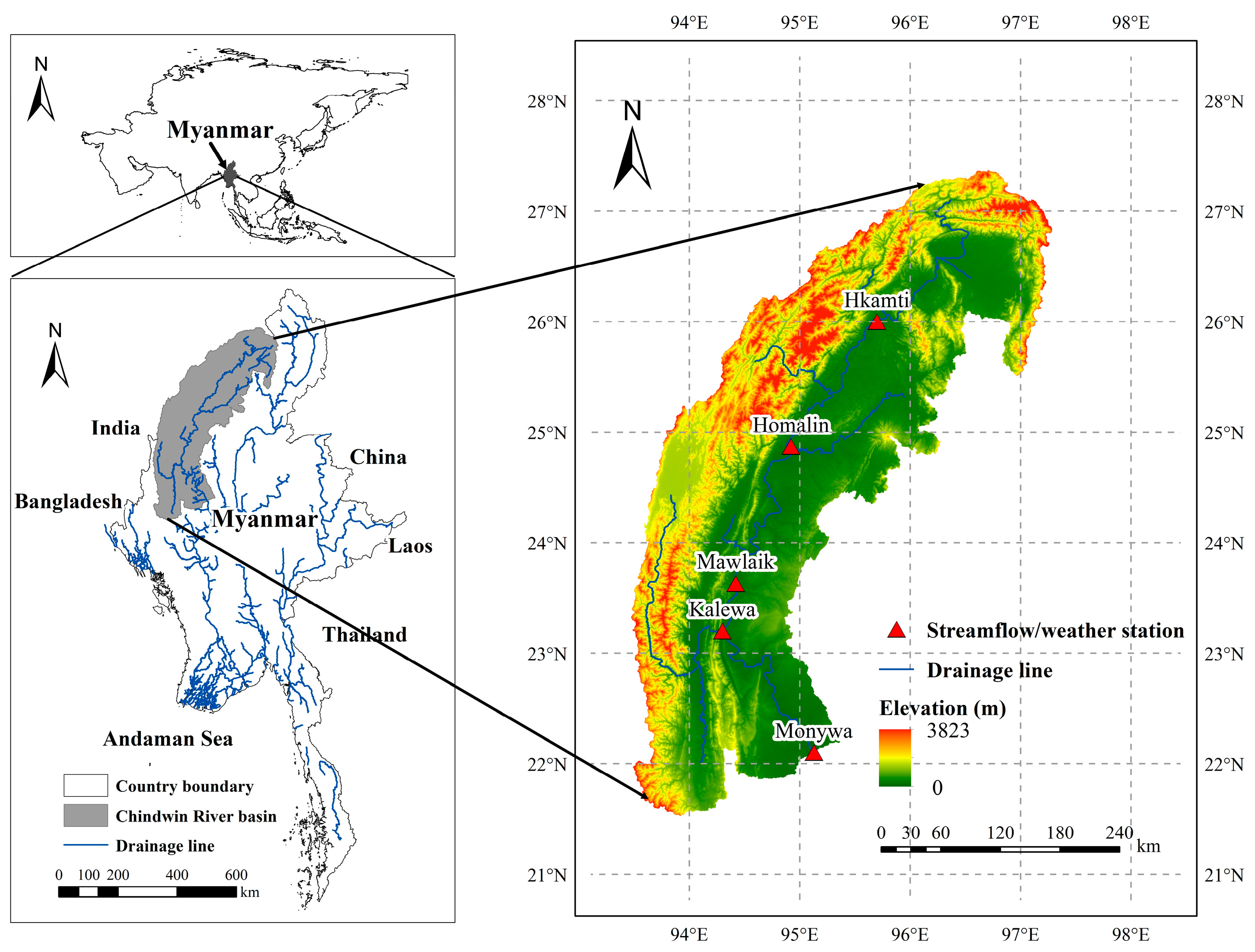

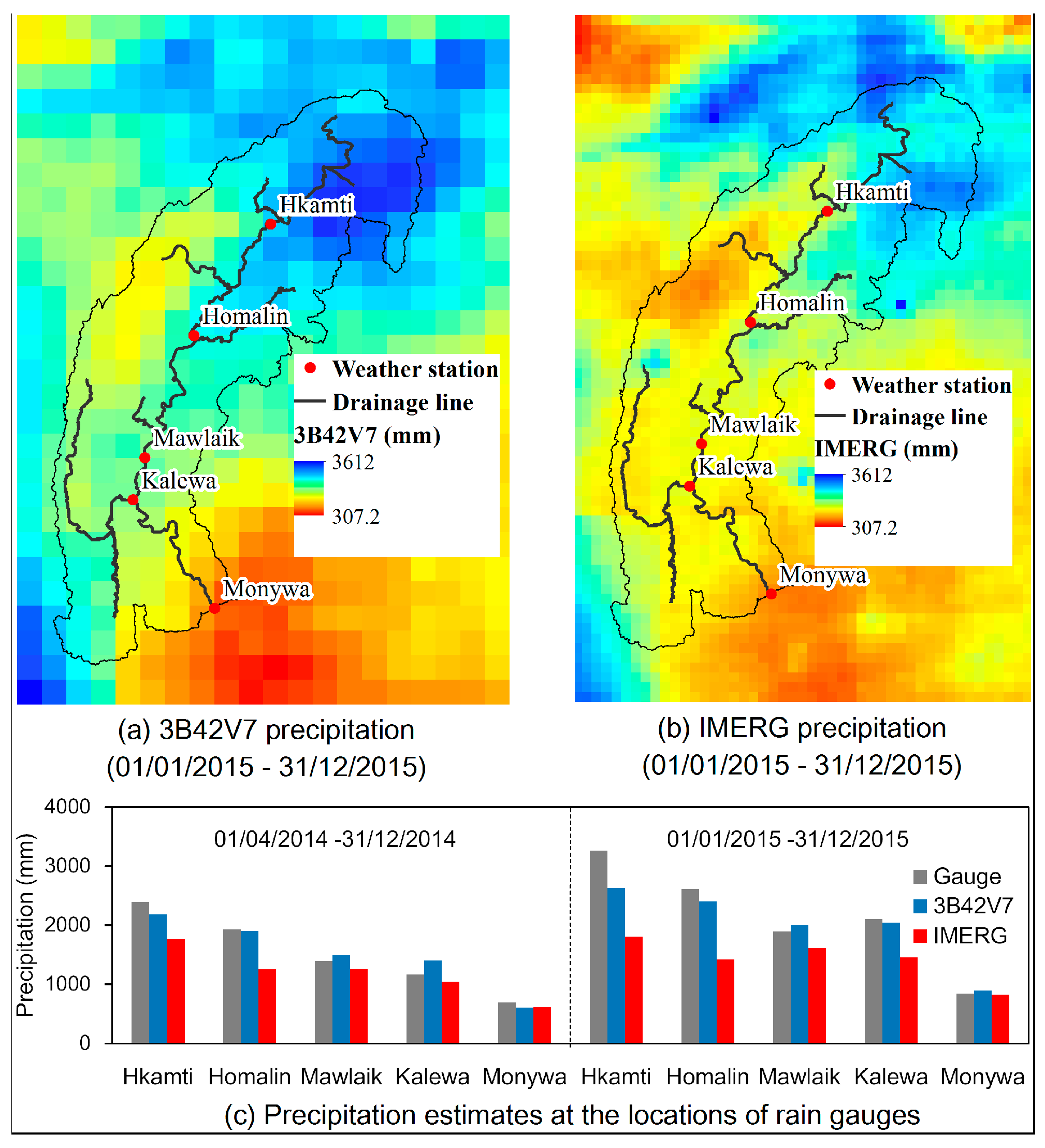
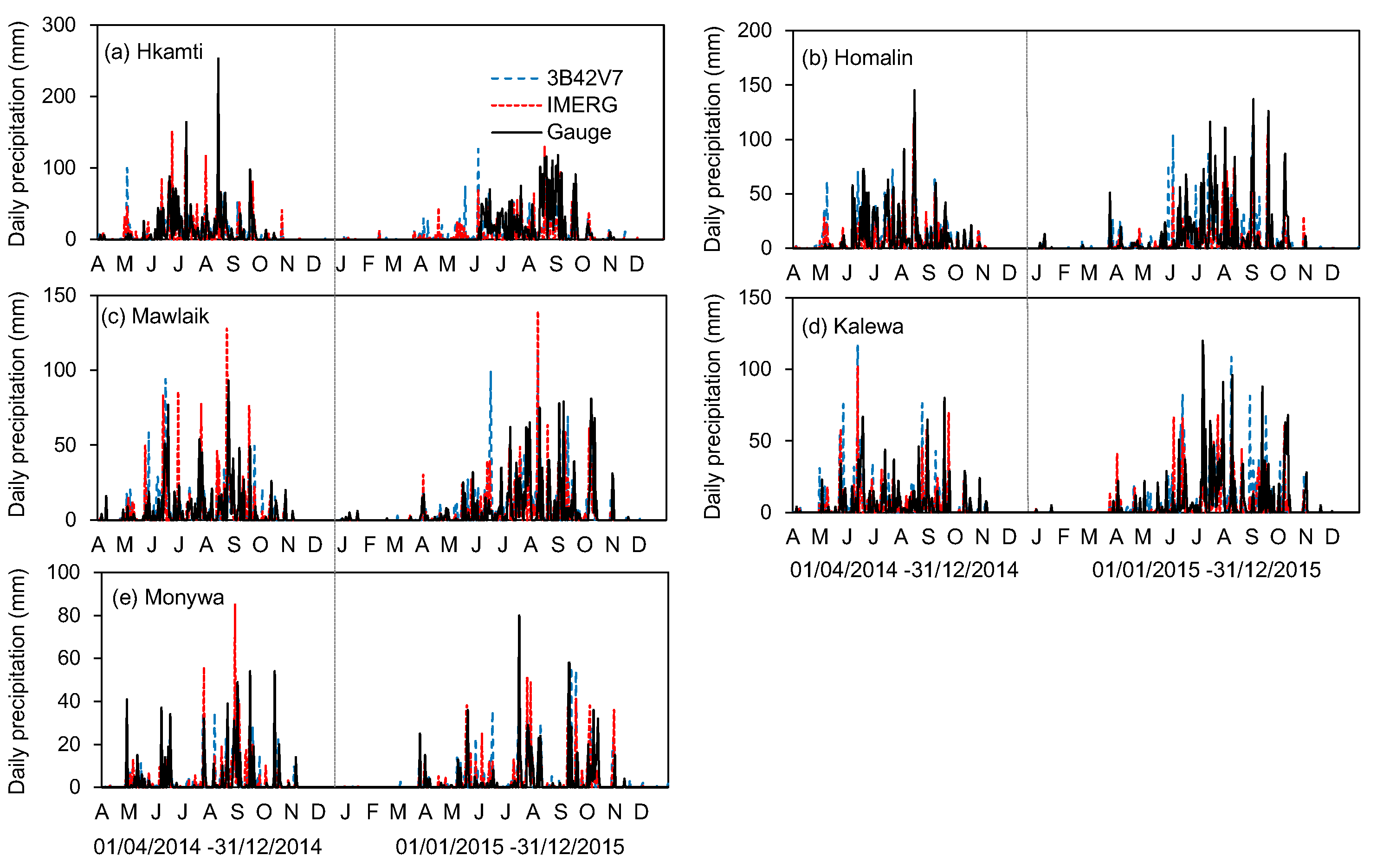
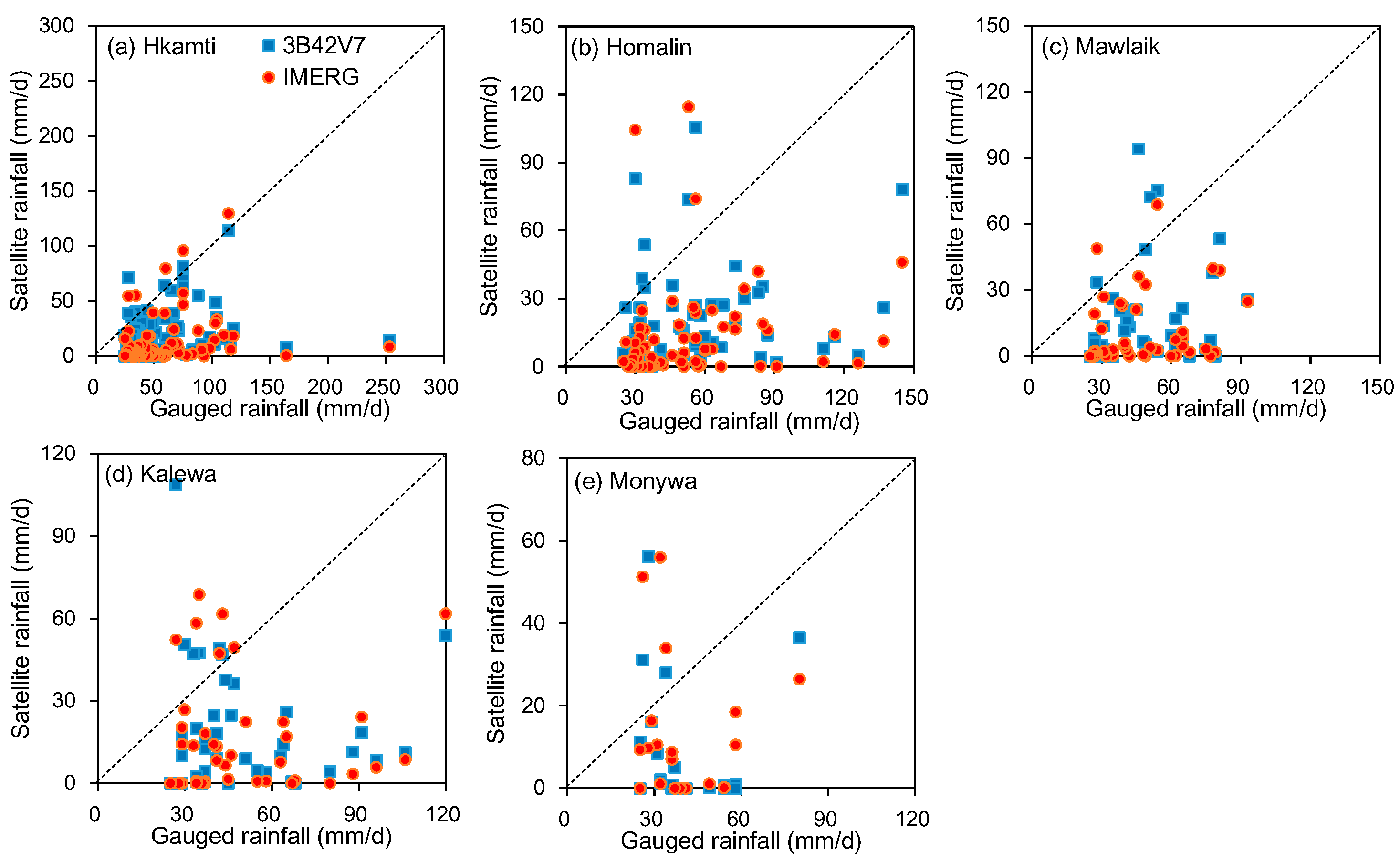
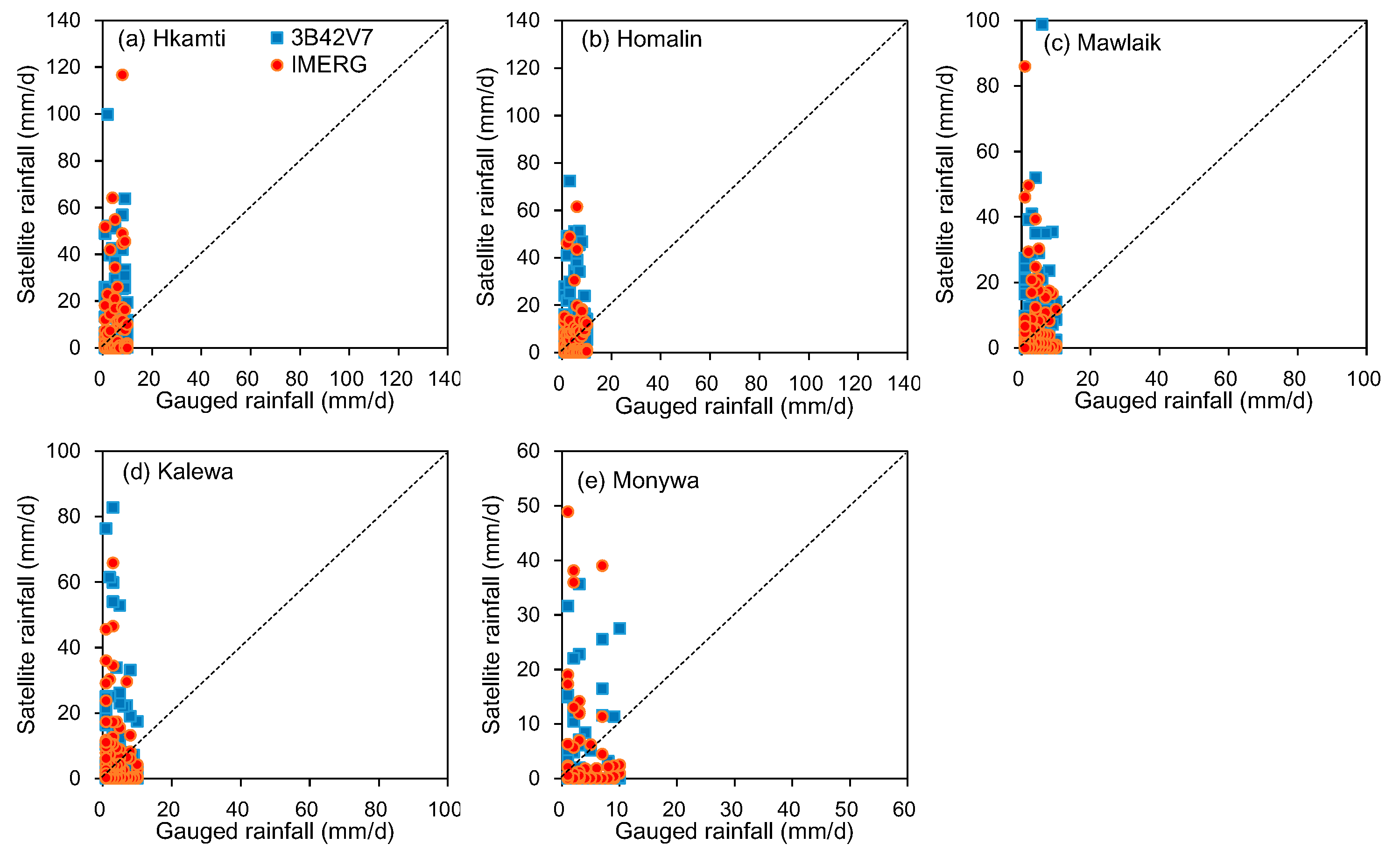
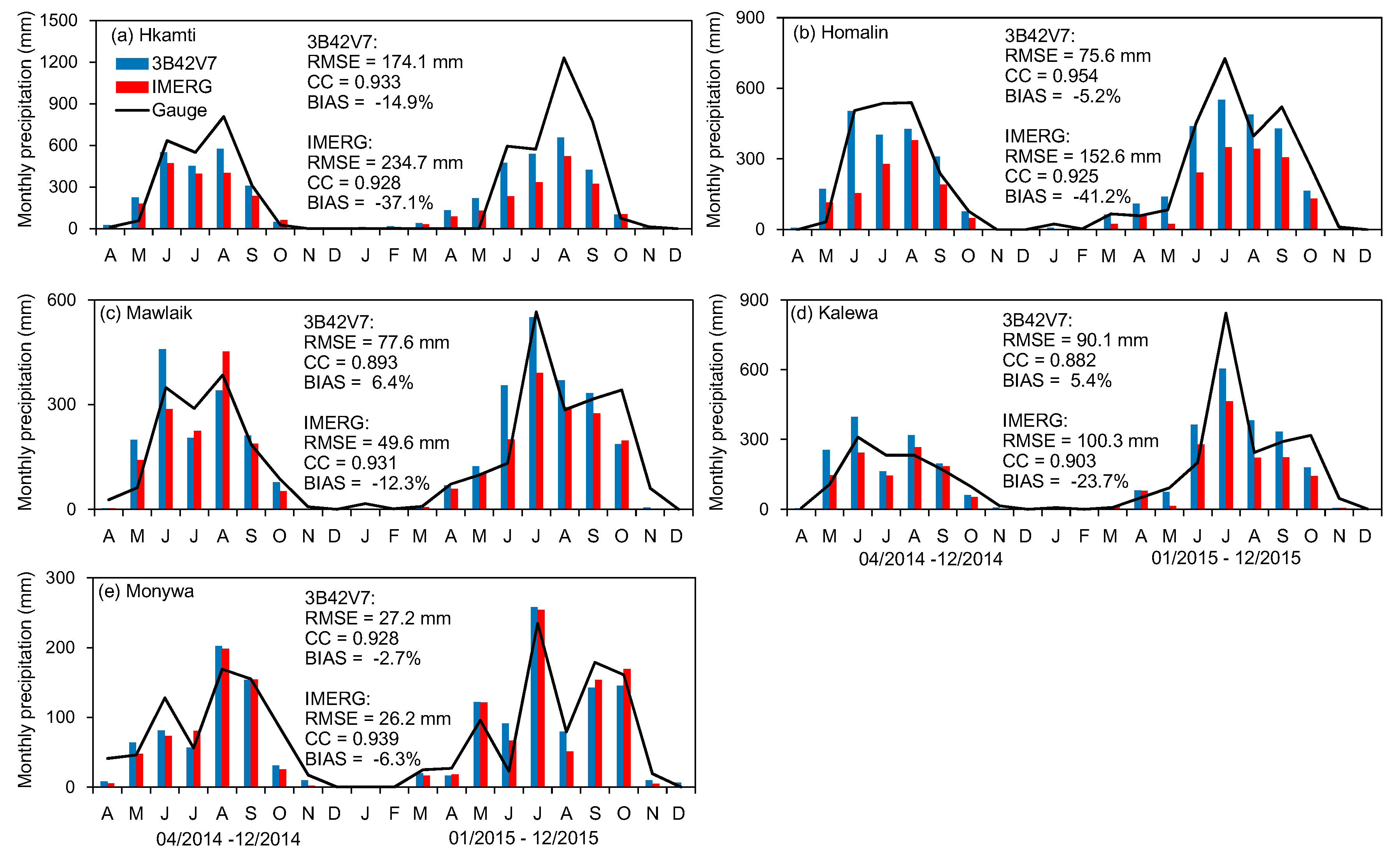
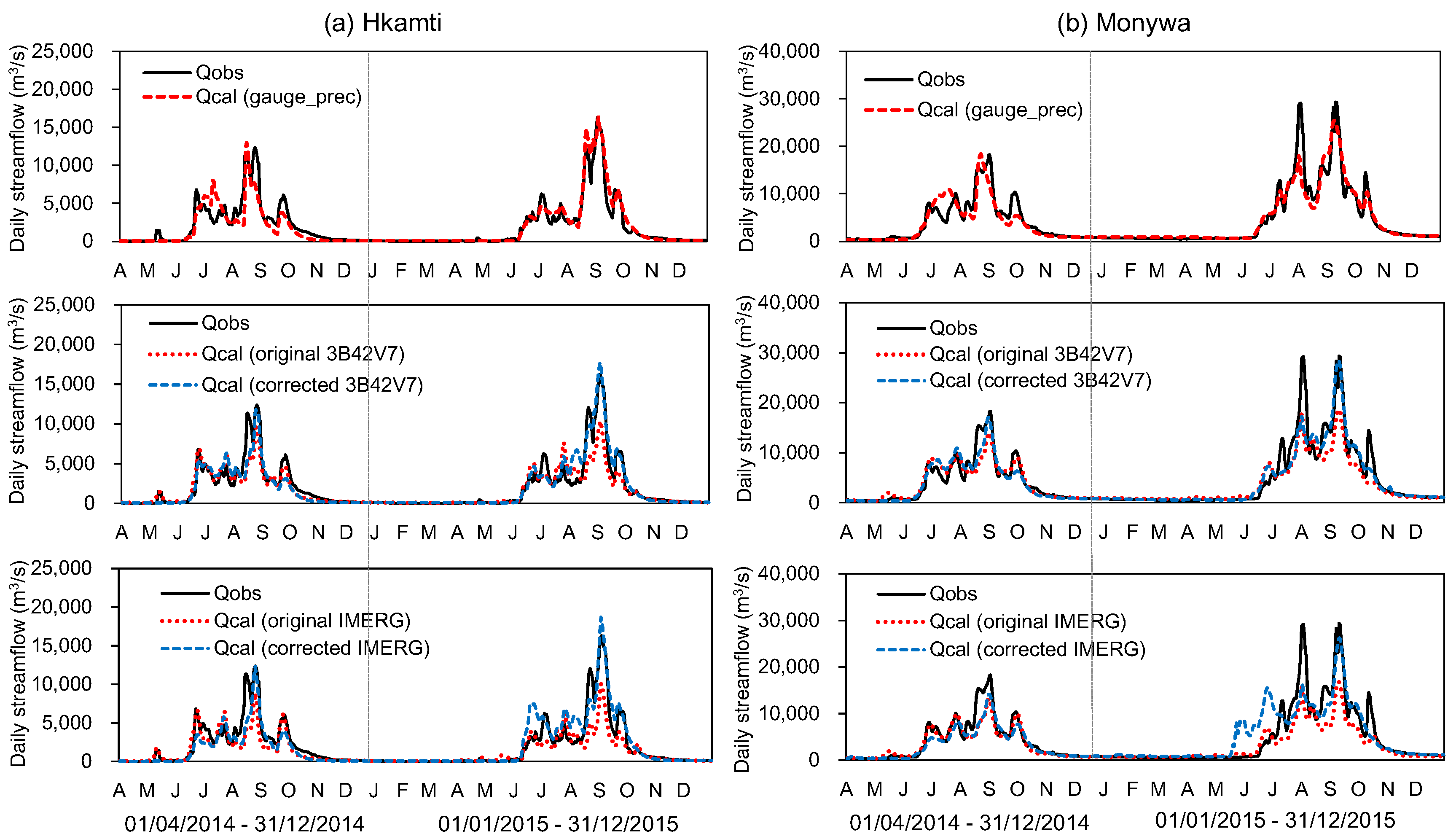

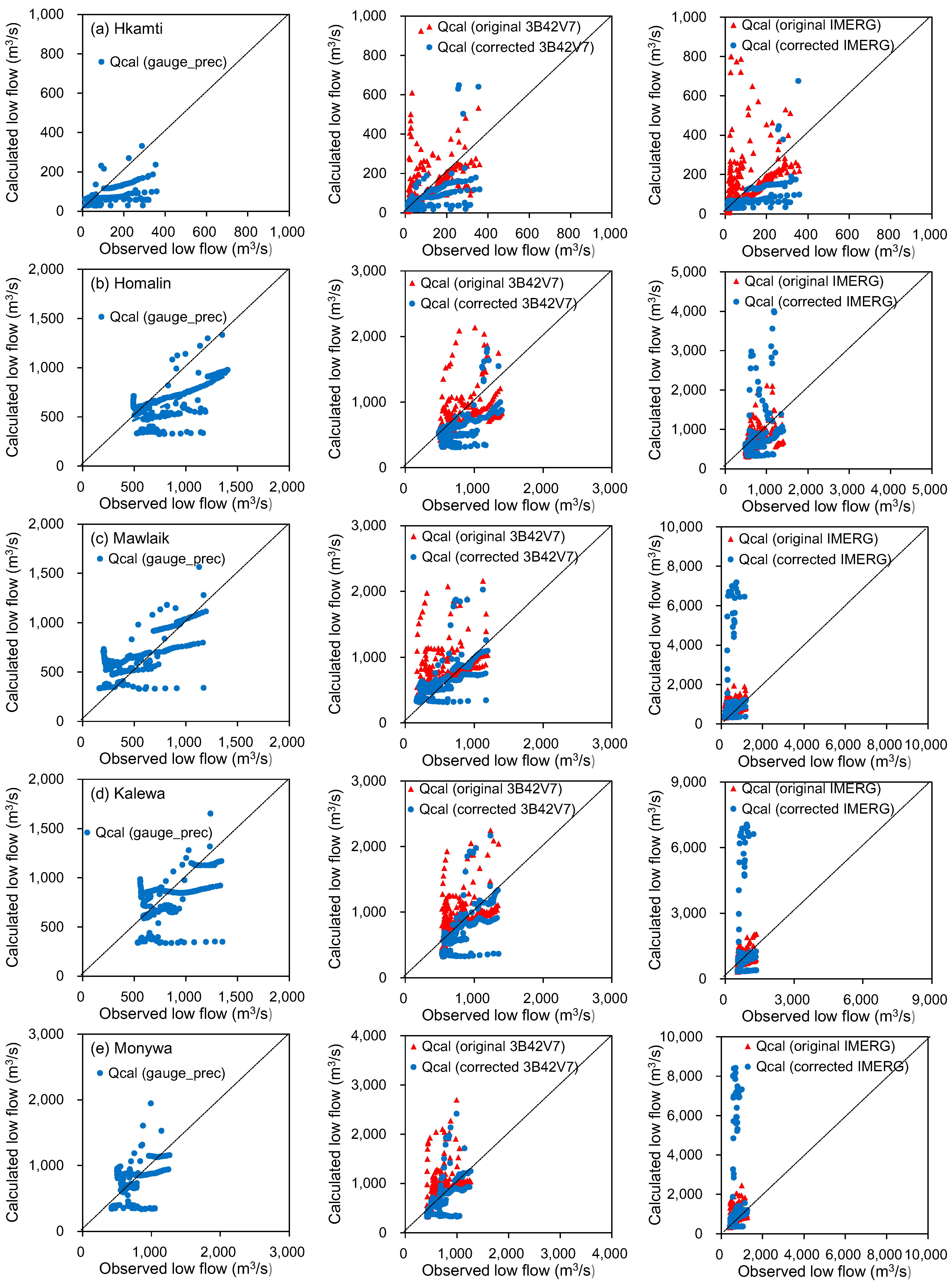
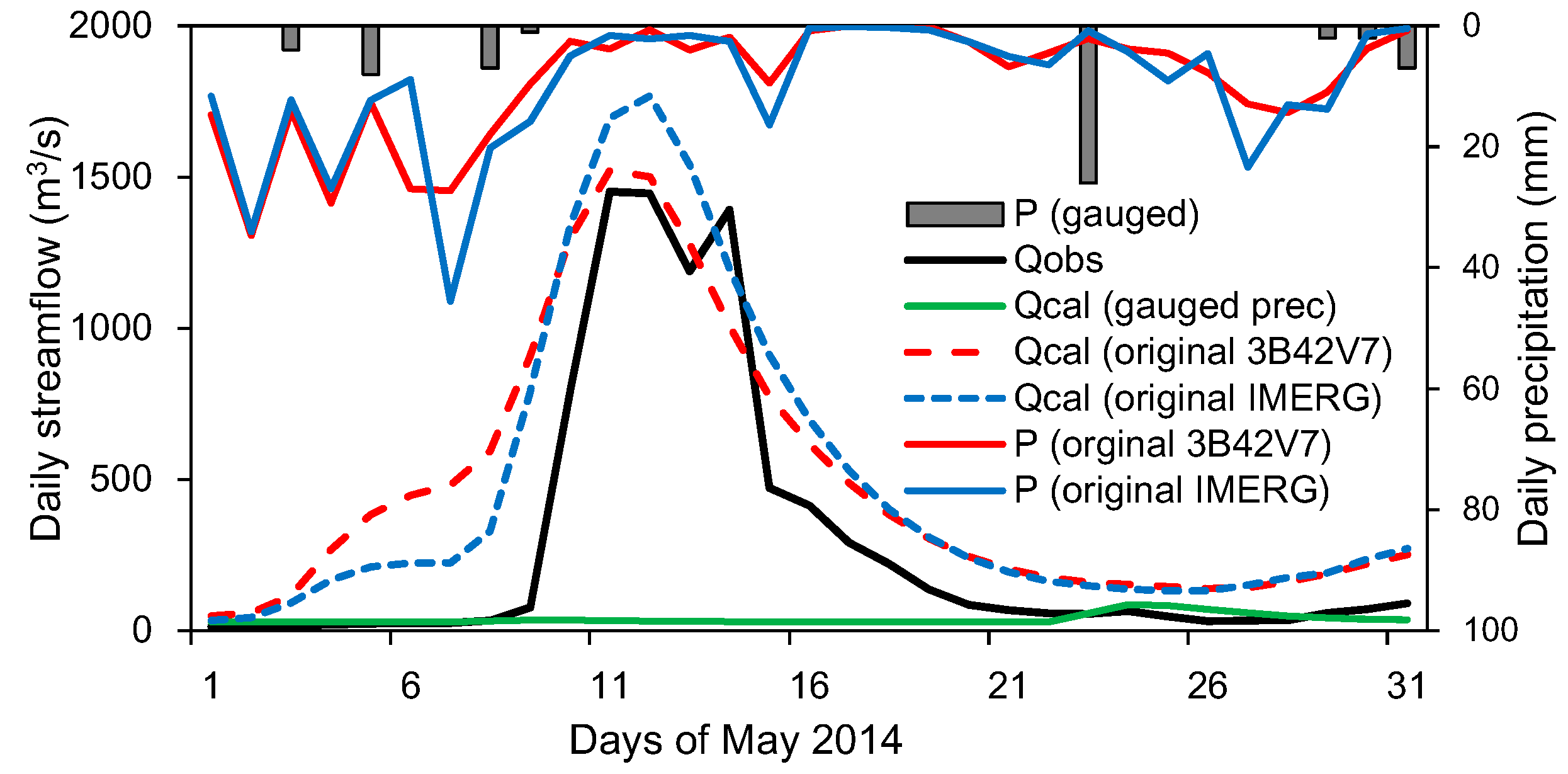
| Weather/Streamflow Stations | Hkamti | Homalin | Mawlaik | Kalewa | Monywa |
|---|---|---|---|---|---|
| Elevation (m) | 387 | 121 | 119 | 126 | 78 |
| Drainage area (km2) | 27,420 | 43,124 | 69,339 | 72,848 | 110,350 |
| Mean annual precipitation (mm) | 3745.5 | 2184.0 | 1716.5 | 1646.4 | 750.4 |
| Mean annual runoff depth (mm) | 2631.0 | 2319.5 | 1800.3 | 1794.8 | 1260.5 |
| Weather Stations | Satellite Precipitation | CC | BIAS (%) | RMSE (mm) | POD | FAR | CSI |
|---|---|---|---|---|---|---|---|
| Hkamti | 3B42V7 | 0.335 | −14.9 | 22.8 | 0.299 | 0.417 | 0.246 |
| IMERG | 0.232 | −37.1 | 24.7 | 0.207 | 0.404 | 0.181 | |
| Homalin | 3B42V7 | 0.320 | −5.2 | 19.3 | 0.253 | 0.440 | 0.211 |
| IMERG | 0.301 | −41.2 | 18.6 | 0.180 | 0.432 | 0.158 | |
| Mawlaik | 3B42V7 | 0.356 | 6.4 | 14.6 | 0.158 | 0.480 | 0.138 |
| IMERG | 0.224 | −12.3 | 16.3 | 0.176 | 0.445 | 0.154 | |
| Kalewa | 3B42V7 | 0.247 | 5.4 | 16.7 | 0.145 | 0.494 | 0.127 |
| IMERG | 0.294 | −23.7 | 15.0 | 0.145 | 0.457 | 0.129 | |
| Monywa | 3B42V7 | 0.281 | −2.7 | 9.0 | 0.092 | 0.626 | 0.080 |
| IMERG | 0.316 | −6.3 | 9.1 | 0.117 | 0.608 | 0.099 |
| Weather Stations | Satellite Precipitation | Heavy Rain Events | Light Rain Events | ||||||
|---|---|---|---|---|---|---|---|---|---|
| CC | BIAS (%) | RMSE (mm) | POD | CC | BIAS (%) | RMSE (mm) | POD | ||
| Hkamti | 3B42V7 | 0.193 | −65.9 | 54.4 | 0.273 | −0.025 | 111.0 | 20.8 | 0.325 |
| IMERG | 0.209 | −77.6 | 59.4 | 0.143 | −0.058 | 65.8 | 25.7 | 0.325 | |
| Homalin | 3B42V7 | 0.157 | −63.8 | 48.0 | 0.317 | 0.086 | 116.1 | 15.5 | 0.413 |
| IMERG | 0.094 | −74.1 | 53.3 | 0.133 | 0.053 | 22.4 | 10.8 | 0.362 | |
| Mawlaik | 3B42V7 | 0.184 | −63.5 | 40.1 | 0.220 | 0.080 | 87.5 | 14.1 | 0.345 |
| IMERG | 0.144 | −75.5 | 42.9 | 0.171 | −0.084 | 45.1 | 12.5 | 0.357 | |
| Kalewa | 3B42V7 | −0.048 | −62.8 | 45.1 | 0.244 | −0.114 | 114.1 | 17.2 | 0.336 |
| IMERG | 0.039 | −67.6 | 45.2 | 0.195 | −0.204 | 46.2 | 12.2 | 0.339 | |
| Monywa | 3B42V7 | −0.068 | −75.3 | 37.1 | 0.200 | 0.096 | 27.8 | 8.5 | 0.319 |
| IMERG | −0.094 | −67.5 | 35.3 | 0.200 | −0.067 | 24.4 | 10.3 | 0.356 | |
| Streamflow Stations | Precipitation Inputs | Entire Simulation Period | High Flows | Low Flows | |||||
|---|---|---|---|---|---|---|---|---|---|
| BIAS (%) | CC | NSE | LogNSE | BIAS (%) | CC | BIAS (%) | CC | ||
| Hkamti | Gauge | −2.9 | 0.939 | 0.874 | 0.857 | −6.7 | 0.811 | −19.3 | 0.583 |
| Original 3B42V7 | −16.6 | 0.908 | 0.769 | 0.901 | −39.3 | 0.820 | 32.6 | 0.519 | |
| Corrected 3B42V7 | −1.9 | 0.945 | 0.890 | 0.866 | −11.3 | 0.886 | −16.6 | 0.554 | |
| Original IMERG | −28.7 | 0.887 | 0.674 | 0.881 | −48.7 | 0.753 | 51.7 | 0.423 | |
| Corrected IMERG | −1.2 | 0.916 | 0.836 | 0.864 | −14.3 | 0.851 | −16.4 | 0.561 | |
| Homalin | Gauge | −0.7 | 0.946 | 0.879 | 0.890 | −1.8 | 0.809 | −21.3 | 0.682 |
| Original 3B42V7 | −16.9 | 0.916 | 0.776 | 0.896 | −37.8 | 0.875 | −3.9 | 0.554 | |
| Corrected 3B42V7 | −5.3 | 0.948 | 0.893 | 0.872 | −10.7 | 0.866 | −22.9 | 0.667 | |
| Original IMERG | −31.2 | 0.905 | 0.641 | 0.810 | −48.9 | 0.800 | −14.3 | 0.489 | |
| Corrected IMERG | 0.6 | 0.916 | 0.825 | 0.848 | −11.5 | 0.810 | −1.8 | 0.397 | |
| Mawlaik | Gauge | −1.8 | 0.947 | 0.894 | 0.916 | −5.7 | 0.718 | 26.3 | 0.755 |
| Original 3B42V7 | −10.9 | 0.947 | 0.849 | 0.882 | −29.5 | 0.815 | 51.4 | 0.485 | |
| Corrected 3B42V7 | −0.9 | 0.953 | 0.902 | 0.913 | −9.3 | 0.831 | 24.4 | 0.657 | |
| Original IMERG | −23.5 | 0.944 | 0.773 | 0.871 | −39.1 | 0.777 | 35.9 | 0.416 | |
| Corrected IMERG | 2.2 | 0.889 | 0.783 | 0.798 | −17.4 | 0.818 | 112.3 | 0.230 | |
| Kalewa | Gauge | −5.2 | 0.911 | 0.827 | 0.917 | −9.9 | 0.375 | −3.1 | 0.553 |
| Original 3B42V7 | −13.1 | 0.926 | 0.809 | 0.908 | −33.5 | 0.696 | 17.1 | 0.490 | |
| Corrected 3B42V7 | −4.7 | 0.924 | 0.848 | 0.919 | −13.5 | 0.565 | −11.1 | 0.696 | |
| Original IMERG | −25.9 | 0.920 | 0.717 | 0.891 | −43.5 | 0.692 | 4.2 | 0.384 | |
| Corrected IMERG | −1.5 | 0.861 | 0.741 | 0.796 | −22.6 | 0.646 | 50.1 | 0.157 | |
| Monywa | Gauge | −4.7 | 0.937 | 0.876 | 0.938 | −11.5 | 0.534 | 8.8 | 0.571 |
| Original 3B42V7 | −14.4 | 0.929 | 0.793 | 0.902 | −36.0 | 0.807 | 33.5 | 0.420 | |
| Corrected 3B42V7 | −5.6 | 0.942 | 0.878 | 0.942 | −16.6 | 0.717 | 0.7 | 0.651 | |
| Original IMERG | −24.8 | 0.930 | 0.718 | 0.883 | −44.1 | 0.824 | 19.8 | 0.326 | |
| Corrected IMERG | −1.3 | 0.866 | 0.761 | 0.771 | −25.8 | 0.764 | 88.5 | 0.108 | |
© 2017 by the authors. Licensee MDPI, Basel, Switzerland. This article is an open access article distributed under the terms and conditions of the Creative Commons Attribution (CC BY) license ( http://creativecommons.org/licenses/by/4.0/).
Share and Cite
Yuan, F.; Zhang, L.; Win, K.W.W.; Ren, L.; Zhao, C.; Zhu, Y.; Jiang, S.; Liu, Y. Assessment of GPM and TRMM Multi-Satellite Precipitation Products in Streamflow Simulations in a Data-Sparse Mountainous Watershed in Myanmar. Remote Sens. 2017, 9, 302. https://doi.org/10.3390/rs9030302
Yuan F, Zhang L, Win KWW, Ren L, Zhao C, Zhu Y, Jiang S, Liu Y. Assessment of GPM and TRMM Multi-Satellite Precipitation Products in Streamflow Simulations in a Data-Sparse Mountainous Watershed in Myanmar. Remote Sensing. 2017; 9(3):302. https://doi.org/10.3390/rs9030302
Chicago/Turabian StyleYuan, Fei, Limin Zhang, Khin Wah Wah Win, Liliang Ren, Chongxu Zhao, Yonghua Zhu, Shanhu Jiang, and Yi Liu. 2017. "Assessment of GPM and TRMM Multi-Satellite Precipitation Products in Streamflow Simulations in a Data-Sparse Mountainous Watershed in Myanmar" Remote Sensing 9, no. 3: 302. https://doi.org/10.3390/rs9030302




